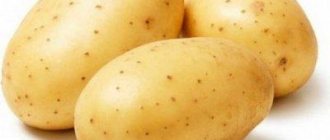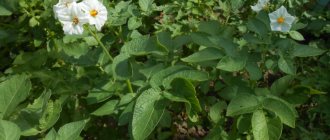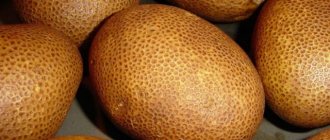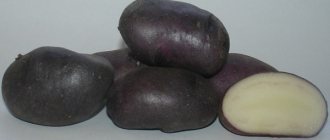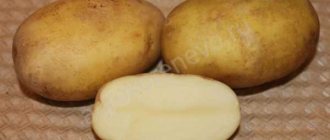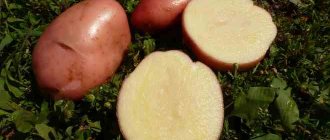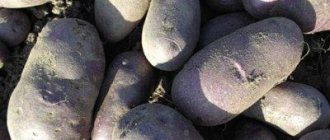Landing
The Vega potato variety does not require special agrotechnical skills, as it easily tolerates temperature fluctuations and changes in humidity. Experienced vegetable growers recommend pre-germinating the tubers and then warming them up.
- Choose healthy tubers with a smooth surface and no signs of disease.
- Install special shelving structures or containers in a well-lit room where the air temperature is from 15 to 17˚ C.
- Place the potatoes in layers on the prepared area.
- In order for the tubers to germinate evenly, it is necessary to rearrange the boxes from time to time.
The first shoots appear after 21 days. You should also harden the sprouted tubers; for this you need to periodically change the temperature conditions sharply (a decrease of 6-8˚ C). This method promotes the activation of gosta eyes and is a guarantee of simultaneous germination of tubers and a high yield.
Soil preparation
Qualitative indicators of the yield of Vega potatoes are observed when planting sprouted tubers on light sandy soils. For effective fruiting, the soil must be properly prepared.
Features of site preparation:
- Choose a dry place to plant tubers.
- Loosen the soil.
- Pour a small amount of wood ash and compost substrate into each hole.
The soil needs to be properly prepared
Such cereal herbs will help enrich the soil with useful microelements during the process of their own decay. In some cases, it is also possible to use ready-made fertilizer solutions for nightshade crops. In autumn, the soil should not be broken into clods. Large soil fractions will freeze better in winter, and along with them most of the weed seeds will be destroyed.
Planting
The characteristics of Vega potatoes imply mid-early planting of sprouted tubers - late April or early May. At this time, the soil warms up well, which promotes further effective growth of tubers.
- Reject tubers without sprouts or with sluggish thin sprouts, as well as small potatoes weighing less than 30 g.
- Planting depth – 10-12 cm.
- Dig holes in increments of 35 to 38 cm.
- The distance between rows is from 70 to 75 cm.
- Place the tubers in the holes and cover them with fertile soil.
The growing season of this varietal variety ranges from 60 to 69 days. According to reviews from experienced vegetable growers, there is no need to water after planting tubers.
During the entire growing season, it is recommended to hill up the bushes at least twice. It is also necessary to ensure that weeds do not spread; for this you need to regularly weed the plants.
Weed control can be done manually. It is also possible to use herbicides, which are an effective way to kill weeds.
Watering
Vega potatoes are very sensitive to watering, so it is recommended to moisten the soil infrequently but generously. To get a high yield, moisture must saturate the soil to 40-45 cm.
The optimal solution to ensure proper watering is the drip irrigation method. Using this method of moistening, moisture will flow directly to the tubers, which will have a positive effect on yield.
Fertilizer
Throughout the growing season, potatoes should be fertilized; it is recommended to carry out two feedings. During the first feeding during the development of tops and the formation of tuber groups, ammonium nitrate or a weak urea solution is used.
During the second feeding, potassium sulfate or superphosphate fertilizers are used. Also, after the flowers have appeared and before the initial stage of withering of the tops, mineral fertilizers should be applied. No further fertilization is required.
Pest treatment
This variety needs treatment for pests. When plants are damaged by the Colorado potato beetle, various control methods are used, including mechanical destruction of pests after manual assembly.
Bushes are treated with the following solutions:
- chemicals Sonnet, Regent;
- herbal tinctures of celandine and acacia.
Also, some gardeners dust the bushes. To do this, pour wood ash into a bucket and use a broom to sprinkle all the bushes, even those that do not have Colorado potato beetles. Dusting can be done using a regular sieve.
Care
How to care:
- Two hillings are carried out per season. Regularly weed the weeds. Get rid of weeds manually or using herbicides;
- The variety is quite susceptible to watering. It is recommended to moisten the soil infrequently but abundantly. To get a good harvest, the soil must be saturated with moisture to at least 40-45 cm;
REFERENCE: The best option is drip irrigation, which will allow moisture to flow directly into the root crops.
- During the growing season, it is recommended to feed the plant twice. During the period of active growth of tops and the formation of root crops, fertilizing is carried out with urea or ammonium nitrate. For the second feeding, superphosphate or potassium sulfate is used. Application of mineral fertilizer is necessary as soon as the potatoes bloom and until the tops wither.
Features of cultivation
The Vega variety prefers light sandy soils. Before planting, the soil is thoroughly loosened and compost or wood ash (preferably birch) is laid out in the holes. Before planting, the tubers are pickled; they can be planted whole or in segments.
When planting, the distance between bushes is 35 cm, row spacing is at least 75 cm. Drip irrigation is recommended to ensure normal soil moisture. Twice during the season, plantings are hilled, weeds are destroyed manually or with the help of herbicides.
Potatoes are little susceptible to mechanical damage; the thin but strong peel reliably protects the tubers when digging. After harvesting, the potatoes need to be dried on the edge or under a canopy, which will ensure good shelf life. During storage, the tubers do not need to be sorted.
The variety is very sensitive to watering. Abundant moisture is necessary during flowering; later the amount of watering can be reduced. During the season, plantings are fertilized 1-2 times with mineral complexes, diluted mullein or bird droppings.
Seed potatoes can be collected independently; they are practically not subject to degeneration. Promising bushes should be marked in advance with bright ribbons. For planting, medium-sized, even potatoes are selected that are not damaged, have not been sick or are not affected by pests.
There are many different ways to grow potatoes. On our website you will find a lot of interesting information about Dutch technologies, cultivation without hilling and weeding, the method under straw, in bags, in barrels, in boxes.
Harvesting
As soon as the stems and foliage are completely dry, begin harvesting. The thin but strong peel is an excellent protection for the tubers when digging. The harvested crop requires mandatory drying.
In sunny weather, tubers can get sunburn, which contributes to crop damage. It is not recommended to leave the collected root crops on the site overnight, since sudden overnight or morning frosts may freeze the crop.
ATTENTION: It is necessary to dry the dug up potato roots on the field for no more than a couple of hours.
Growing
Inventory
Some gardeners have already mechanized their work and use a special garden planter or walk-behind tractor to plant potatoes. But in small areas, the traditional manual planting method and proven garden tools are used:
- bayonet shovel;
- hoe;
- rake;
- pitchfork;
- hand hoe;
- shovel for digging up the garden and digging potatoes.
Soil preparation
The Vega variety grows best in light and fertile soil. Soil fertilization is done in the fall. They scatter manure around the area and then dig it up thoroughly. Cultivation is carried out in the spring in warm weather immediately before planting potatoes.
Preparation of planting material
For planting, select tubers of small size, approximately the size of a chicken egg, without signs of disease, severe damage, regular shape and uniform color.
A few weeks before planting, these potatoes are laid out in wooden boxes in layers of 2-3 tubers. For good air circulation, the boxes must have gaps between the boards. The room temperature should be at least 15-17°C with average humidity. If the air is very dry, the planting material is sprayed with water several times a day.
Important!
To increase the number of eyes, simultaneous germination of tubers and increase yield, hardening of planting material is necessary. To do this, lower the temperature by 6-8°C once a day for a few minutes.
The room should be bright. Tubers are considered ready for planting if several gray-white shoots with a thickness of 3 mm and a length of at least 2 cm have formed on them.
Boarding time
Depending on the growing region, potato planting begins from late April to mid-May. The main reference point is the soil temperature. The soil should warm up to a temperature of + 8-10°C.
Scheme
- Holes are dug to a depth of 10-15 cm; for northern regions, 20 cm is possible.
- The distance between the holes should be at least 30 cm, and the row spacing should be 60-70 cm.
- To improve productivity, 50 g of humus, wood ash or saltpeter can be placed at the bottom of the hole.
- The tubers are placed sprouts up and covered with a small hill of earth.
- The soil is not compacted so as not to damage the shoots.
Care
Vega potatoes do not require special care. It is necessary to follow the rules that gardeners use to grow any type of potato and take into account some of the features of the Vega hybrid.
Hilling
Attention!
Experts have found that if hilling is not carried out, the yield is reduced by 20%.
Indeed, with this type of work we not only reduce the spreading of the bush, but also clear the soil of weeds. Therefore, it is necessary to hill up at least twice a season. The first time is when the sprouts have just appeared and the second time when the height of the tops reaches 15 cm.
Watering
A special feature of the Vega variety is its sensitivity to watering. In order for the soil to be evenly moistened to a depth of 40-45 cm, not frequent but abundant watering is necessary. Some experts recommend starting to water potatoes when the tops grow to 10 cm and stop immediately after flowering. In summer, one or two waterings per week are enough, but drip irrigation solves all problems.
Weeding
In terms of the structure of the root system, potatoes are inferior to many weeds. Therefore, they not only take away nutrients and moisture, but can also destroy the tuber. Weeding is done twice a season. The first time is when the stems just emerge from the ground, the second time is before flowering. Therefore, it is better to combine weeding with hilling.
Top dressing
To increase the yield, it is advisable to fertilize the plants twice a season. Ammonium nitrate or urea is used during the formation of tubers and abundant growth of the bush, but after flowering and before the tops wither, mineral fertilizers are applied.
Other care measures
In very hot seasons, which the Vega variety tolerates normally, it is possible to mulch the beds to avoid severe drying out of the soil. For this, it is better to use organic substances rather than film. Mulching with straw will not only retain moisture in the soil, but will eliminate the need for weeding, limiting the spread of annual weeds.
Planting and caring for Vega potatoes
The variety does not require special agrotechnical conditions. According to the manufacturer's description, potatoes tolerate variability in climatic conditions, soil structure, and humidity changes well. The only condition is the traditional pre-planting preparation of soil and root crops.
Selection and preparation of a landing site
To get a high-quality harvest of Vega potatoes, you should prepare the area before planting. First, select the soil with the most suitable structure - light sandy soil with mandatory adherence to crop rotation recommendations. Then prepare the area in advance.
- In the fall, sow the area of the future potato bed with green manure. The optimal time is mid-September (no later). Barley, wheat or rye should be sown before the Vega variety.
- Before the start of winter, dig up the ridges, leaving large clods of earth without breaking them. This reduces the number of weeds. After the earthen lumps freeze, their seeds lose their viability.
- In the spring, loosen the area and prepare furrows or holes. Place a layer of compost and wood ash on the bottom.
For industrial scales, soil preparation and planting are done mechanically.
Preparation of planting material
The quality of the harvest depends on the degree of preparation of the tubers. Seed material must be healthy and undamaged. The second condition is that the seeds need to be germinated. For early potatoes, the Vega variety is an important factor. In the case of germination, vegetable growers harvest earlier than usual.
- Bulkhead. Select intact specimens without signs of deterioration. If you come across tubers of a shape uncharacteristic for the variety, it is better to set them aside for cooking. Small specimens (less than 30 g) are also not suitable.
- Germination. It is optimal to lay out the seed material in layers in boxes or on racks. The air temperature during this period is maintained at + 15-17 °C, and good lighting is required. Periodically it is necessary to rearrange the containers and moisten the potatoes so that germination occurs evenly.
- Hardening. After the sprouts appear, sharply reduce the temperature by 6 °C 2-3 times, then raise it again. Such an event stimulates the growth of eyes.
Tubers ready for planting require careful handling so that the tender sprouts do not break off.
Landing rules
The ideal period for planting is late April or early May. The date varies depending on the region and weather conditions of the current year.
Planting consists of several stages:
- Rejection. This includes removing root vegetables with or without stringy shoots.
- Preparing rows or holes. For Vega potatoes, 10-12 cm is considered sufficient depth. The distance between rows is 70-80 cm, between tubers 35 cm.
- Fertilizing during planting. The variety benefits from the addition of ash and compost.
- Spread the seeds and cover with soil.
According to the description and reviews, the characteristics of the Vega potato variety make it possible not to water the beds after planting.
Watering and fertilizing
One of the important nuances of growing the Vega variety is its sensitivity to watering. Potatoes require abundant, but not frequent, moisture. The main indicator is soil saturation to a depth of 40 cm or more. An excellent option is to install drip irrigation.
Summer cottage plot || DIY 3D printed robotic lawn mower || 5 cool ideas for country furniture that you can make yourself || 15 varieties of dahlias that will decorate your garden
For Vega, feeding twice per season is sufficient. In this case, the Dutch variety will form a good harvest. The first nutrition must be applied during the formation of tubers. Nitrogen fertilizers are needed, of which the most suitable for Vega are urea or ammonium nitrate. The second time feeding is necessary after the beginning of the flowering phase. Potassium sulfate and superphosphate are added, which stimulate fruit growth.
Loosening and weeding
Regular weeding of rows protects potatoes from the growth of weeds. Vega reacts negatively to lack of moisture and nutrition, so competitors in nutrient consumption must be destroyed. In addition, weeds are carriers of diseases and serve as a refuge for pests.
Hilling
Early potato varieties need protection from return frosts and spring temperature drops at night. To do this, hill up the bushes. The first time for Vega potatoes is advisable after the first sprouts appear. The procedure must be repeated at least 3 times during the growing season of the bush.
Characteristic
Vega is an early ripening table variety. Harvest ripening occurs 60-70 days after planting.
Vega is ideal for industrial cultivation. In addition to high yield (about 250-300 c/ha), the variety boasts good transportability due to its dense shell. Also, the shell protects the tubers from damage during mechanical harvesting (which is constantly practiced in industrial production).
Vega potatoes are unpretentious to growing conditions. It is not afraid of long periods of drought and does not suffer from short-term spring frosts.
The variety has good immunity, protecting it from potato cancer, mosaic and golden nematode. Vega is not protected from late blight, but also does not have a tendency to constantly become ill with this fungus.
As noted above, Vega is famous for its productivity, which can reach 500 c/ha (rarely). On average, the yield does not exceed 300 c/ha. Moreover, each bush produces up to 8-10 large root crops.
Characteristic features of the Vega variety:
- The culture forms medium-sized bushes of an erect type. The height of mature tops does not exceed 50 cm.
- The leaves have a characteristic waviness along the edges. The color of the leaves is intense green. The number of leaves on the shoots is small.
- During the growing season, the bush blooms with large cream flowers. They are collected in a neat corolla.
Characteristics of tubers:
- The tubers are oval with small, shallow, barely noticeable eyes.
- The weight of a ripe root crop is 90-120 g.
- The potato is covered with a medium-thick yellow shell.
- The amount of starch in tubers ranges from 10% to 16%. The percentage of this substance is affected by the quality of the soil. The more nutritious the soil, the more starch, the less nutritious the soil, the less starch.
- The pulp is light lemon color. Does not darken when cooked, fried or damaged.
- Tubers have high shelf life, up to 99%.
Advantages and disadvantages of the variety
The variety has a lot of advantages, thanks to which it has gained good popularity in a short time:
- Good taste.
- Lack of deep eyes.
- Large tubers with a “dry”, non-watery structure.
- Simultaneous ripening of root crops.
- High shelf life - 99%.
- Versatility – Vega is suitable for use in any form.
- The variety is resistant to most known fungal diseases.
There are no disadvantages as such. One can only note the sensitivity to irrigation and frequent damage by the Colorado potato beetle. But these shortcomings can be attributed to any potato variety.
Characteristic
The potato variety "Vega" belongs to the mid-early table variety. From planting the tubers to the first harvest, 60-70 days pass. The collected tubers are perfectly stored without losing their commercial properties (keeping quality reaches a record 99%). Long distance transportation is possible. Smooth, very beautiful tubers are ideal for sale.
Read more about shelf life, temperature and emerging problems. And also about storage in winter, on the balcony, in the refrigerator, in boxes, cleaned.
In the table below, for comparison, we have presented information on such characteristics of other potato varieties as marketable tuber weight and keeping quality:
| Variety name | Weight of marketable tubers (grams) | Keeping quality |
| Vega | 90-120 | 99% |
| Lady Claire | 85-110 | 95% |
| Innovator | 100-150 | 95% |
| Labella | 180-350 | 98% |
| Bellarosa | 120-200 | 95% |
| Riviera | 100-180 | 94% |
| Gala | 100-140 | 85-90% |
| Lorch | 90-120 | 96% |
| Limonka | 75-150 | 90% |
The great advantage of the variety is its high yield. When grown on fertile soils, up to 500 centners of selected potatoes can be harvested from 1 hectare. The average yield is from 230 to 380 centners per hectare.
The table below shows for comparison the yield indicators of other potato varieties with different ripening periods:
| Variety name | Productivity |
| Vega | 230-380 c/ha |
| Tuscany | 210-460 c/ha |
| Rocco | 350-600 c/ha |
| Nikulinsky | 170-410 c/ha |
| Red Lady | 160-340 c/ha |
| Uladar | 350-700 c/ha |
| Queen Anne | 100-500 c/ha |
| Elmundo | 245-510 c/ha |
| Asterix | 130-270 c/ha |
| Slav | 180-330 c/ha |
| Picasso | 200-500 c/ha |
Medium-sized bushes, erect or semi-erect, intermediate type. The foliage is average. The leaves are simple or intermediate, dark green, with slightly wavy or medium wavy edges. Berries are few. Large white or cream flowers are collected in compact corollas. The sprouts are white, slightly pubescent.
At least 10 large potatoes are formed under each bush. The amount of non-commercial small items is insignificant.
Vega potatoes are undemanding to growing conditions. It tolerates minor errors in agricultural technology and tolerates light frosts, heat or drought. Productivity increases significantly with timely fertilizing. Read more about what to feed potatoes, when and how to apply fertilizers, and how to do it correctly when replanting.
Frequent hilling, weed removal and mulching are required.
The variety loves moisture very much, but does not tolerate stagnation of water in the soil. To increase productivity, frequent watering during the flowering period is recommended, after which the amount of moisture can be reduced.
The variety is slightly susceptible to the main diseases of nightshades: potato canker, tobacco mosaic, and cyst nematode. Resistant to viruses of various types, blackleg, common scab. Early ripening protects plantings from late blight of leaves and tubers. Fungal diseases are possible.
The tubers have a pleasant, rich taste, without being watery or excessively dry. The average starch content makes root vegetables versatile; they are suitable for deep-frying, seasoning soups, preparing side dishes, vegetable chips, stuffing, and baking. The tubers do not boil over and retain their shape. Not suitable for making purees.
Yellow pulp indicates a high carotene content, which makes it possible to recommend potatoes for baby and dietary nutrition. During cutting and cooking, root vegetables do not darken, maintaining a beautiful golden color. Potatoes are suitable for preparing semi-finished products: frozen slices, chips, vegetable mixtures.
Disease and pest control
Like many vegetable crops, potatoes are susceptible to pest attacks and diseases.
- The threat to all types of potatoes is the Colorado potato beetle. Its larvae are very voracious, they can severely damage the foliage and stems of the plant. Insects from the bush must be collected by hand and destroyed. To prevent further pest attacks, the tops should be sprayed with insecticides.
- A good preventive measure against fungal diseases and ring rot is dusting plants with stove ash. It is best if it comes from birch wood. This method also helps in the fight against pests.
- Tubers are often affected by wireworms. It penetrates into the pulp of the fruit, which leads to rotting and a significant loss of crop quality. To combat this scourge, fertilize with superphosphate fertilizers. Chemicals are also used.
- In rare cases, potato tops can be affected by aphids. To get rid of the larvae that eat the foliage, the bush needs to be sprayed with a soap solution.
Pests and diseases
When developing the variety, breeders paid attention to the plant’s immune system: Vega potatoes are not affected by late blight, nematodes and cancer. When carrying out preventive measures, the bush is resistant to wrinkled mosaic.
To prevent the development of diseases, you should adhere to the rules of agricultural technology. During the season, it is necessary to treat the potato bush with Bordeaux mixture or Fitosporin-M 2-4 times.
The main pest is the Colorado potato beetle. It destroys leaf blades and shoots, which leads to the death of the plant. The main measures to combat it are mechanical destruction of both adults and larvae.
Folk remedies against the Colorado potato beetle are ineffective; the drugs Sonet or Regent are recommended
How to grow potatoes
The quality of the finished product is affected not only by proper care during the growing season, but also by pre-sowing treatment of seed material. If you follow the necessary and simple rules, a rich and tasty harvest is guaranteed.
Pre-sowing preparation
Tubers weighing no more than 100 g are selected for planting material.
The preparation of tubers begins 1 month before sowing in the ground. Selected potatoes are laid out in a bright room for germination. The temperature is maintained at +15°C. Within a month, the sprouts on the tubers grow to 1.5-2 cm.
Immediately before planting, the seed is treated with a weak solution of potassium permanganate or the drug “Fitosporin” for disinfection purposes.
Timing, scheme and technology of planting
They begin to plant in the ground in late April or early May.
The soil chosen is light and fertile. For lightness, river sand or peat is added to it.
The soil is prepared in the fall, dug up and humus and wood ash are added for fertility.
Planting pattern: 35 cm – distance between seedlings, 70 cm left between rows. The depth of the holes is no more than 15 cm. A little wood ash is placed at the bottom of each and filled with water. After planting, the tubers are covered with soil and slightly moistened.
Further care
Caring for the variety does not involve any complex procedures. All agricultural practices come down to standard cultivation rules, namely: watering, loosening, weeding and hilling.
The main thing is to maintain the regime and avoid excess or lack of moisture. Although the crop is adapted to long-term drought, you should not abuse this feature if you want to get tasty, marketable tubers.
Watering
The plantings are watered for the first time when the seedlings reach a height of 10 cm. Before this, they are irrigated only when the soil is very dry. In the future, water infrequently, but abundantly. Be sure to control the humidity level in the beds
This is especially important for all plants susceptible to fungal diseases
After watering, loosening is carried out. Access to oxygen to the root system is necessary for the full growth of bushes and strengthening their immunity. During loosening, weeding is carried out, removing all weeds with roots so that they do not interfere with the healthy growth of seedlings.
Hilling up is no less important a procedure than watering or loosening. Promotes the formation of new roots, which has a beneficial effect on fruiting. Plants are hilled three times a season, raking the soil from the rows onto the bushes with a hoe. In addition, hilling protects the tubers from exposure to sunlight.
Feeding
Seedlings are fed at least 2 times per season
During the flowering period and at the time of fruiting, the crop is fertilized with a complete mineral complex with a predominant content of potassium and phosphorus.
If the bushes grow poorly after replanting, nitrogenous substances are used to help the plants grow green mass.
Disease and pest control
Late blight is the most serious disease for nightshade crops and is difficult to treat. Compliance with planting technology and pre-sowing treatment is a mandatory and important preventive measure.
With a sufficient distance from each other, the seedlings will be ventilated and receive the required amount of light. With moderate watering, the humidity level will not be exceeded, which means the risk of developing fungal spores will be reduced.
Another important and necessary measure in the fight against late blight is compliance with crop rotation rules. Potatoes are not planted in the same beds where peppers, eggplants and tomatoes used to grow. The best predecessors are greens and legumes. After them, the soil retains fertility, being saturated with nitrogen.
When carrying out the prevention of fungal diseases, do not forget about insect pests, from which seedlings suffer no less than from diseases:
The Colorado potato beetle is capable of destroying plantings in a few days. In addition to adults, larvae are dangerous for plants
When inspecting bushes, it is important to turn over the leaves, otherwise the larvae will go unnoticed. In case of mass damage, use the insecticide "Prestige"
If the quantity is small, the beetle and larvae are collected by hand.
The wireworm lives in the soil and attacks root crops, which subsequently rot in the ground. Digging the soil in the fall and before spring planting is an effective preventive measure in the fight against the pest. Also, the wireworm does not tolerate mustard, so when planting tubers, it is enough to pour a little mustard powder into the holes.
Collection, storage and use of crops
The crop is dug up with a shovel or pitchfork. Thick skin reduces the risk of mechanical damage to root crops. Dig potatoes as soon as the foliage begins to fade .
After harvesting, the tubers are laid out to dry in the sun for several hours. Before storing vegetables for long-term storage , they are carefully inspected and spoiled ones are disposed of.
Potatoes are placed in wooden boxes and left in a cool, dry room. Vega has a high shelf life , so the tubers retain their presentation and taste until spring. Long-term transportation also does not affect the safety of the finished product.
Ripe vegetables have a universal purpose and are used not only in private households, but also in large-scale industries . They are used to prepare chips, semi-finished products and fast food. Potatoes are also readily purchased by restaurant chains. In households, all kinds of dishes are prepared from Vega, which are distinguished by their rich taste and pleasant color.
Characteristics and description
The variety is classified as an early ripening table variety. The growing season ranges from 60 to 70 days. It tolerates light frosts and drought well, and is unpretentious for growing on various types of soil. The variety is suitable for cultivation on an industrial scale. Thanks to the dense skin of the root crop, potatoes can be harvested mechanically and transported over long distances. It should be noted that it has excellent resistance to late blight and other diseases.
Appearance and photo
Escapes
The bushes grow of medium size, up to 50 cm in height, of an erect or semi-erect type with medium foliage. The medium-sized leaf plate is dark green in color and has a slightly wavy edge. During flowering, corollas with large white or light cream flowers form on the bushes.
Roots
On average, the bush produces 8-10 tubers. Potatoes have the correct shape with a smooth surface. The peel is yellow without spots and has a mesh structure - not thick, but very durable. There are few eyes on it and they are shallow. The cut flesh is granular and has a uniform lemon color.
Seeding rate and yield per 1 ha
The sowing rate for potatoes on large areas is usually calculated by an agronomist using special tables. Taken into account:
- planting method (single or double rows);
- climatic conditions;
- mass of tuber in seed;
- ripening period;
- appointment.
Advice
To plant the food grade Vega, usually 30 thousand tubers weighing 70-80 g are enough - that’s 25 centners per hectare. Average yield is from 230 to 380 c/ha.
Taste
According to the classification of the European Association for Potato Research (EAPR), the Vega variety is assigned culinary type B. The taste of this hybrid is beneficially affected by the low content of the glucoalkaloid solanine. The delicate aroma is especially noticeable in young boiled potatoes.
Chemical composition
The chemical composition of potatoes depends on the soil on which they were grown, but each variety has its own characteristics of accumulation of starch, sugars, fatty acids, protein and dry protein. Vega is a medium-containing variety in terms of dry matter (20-25%). At the same time, the starch content in it is from 10.1 to 15.9%.
Resistance to diseases and pests
Plants of this species are moderately resistant to common scab and have good resistance to potato blight, rhizoctonia and nematode. They have increased immunity to late blight.
Keeping quality
Vega root vegetables can be stored for a year without losing their taste and presentation. Tubers do not darken when struck and are not prone to sprouting. Therefore, the shelf life of this variety is 99%.
Consumer qualities
These potatoes are good for any cooking method:
- frying;
- cooking;
- as an ingredient in soups and salads;
- baking.
But due to poor cooking, the puree is not tender enough. In industry it is used for the production of chips, baby food and diet food.
Potatoes of the Vega variety were approved for cultivation in the Central region of the Russian Federation (Bryansk, Vladimir, Ivanovo, Kaluga, Moscow, Ryazan, Smolensk, Tula regions). But since Vega tolerates frost and drought well, gardeners grow this variety throughout Russia.
Potatoes "Vega": variety description and photo
| Variety name | Vega |
| general characteristics | early table variety, easily tolerates temperature changes and drought |
| Maturation period | 50-65 days |
| Starch content | 10-16% |
| Weight of marketable tubers | 90-120 gr |
| Number of tubers in a bush | 8-10 |
| Productivity | 230-380 c/ha |
| Consumer qualities | Great taste, suitable for baby food |
| Keeping quality | 99% |
| Peel color | yellow |
| Flesh color | dark yellow |
| Preferred Growing Regions | Central |
| Disease resistance | resistant to nematodes, potato blight and late blight |
| Features of cultivation | germination recommended |
| Originator | Norika Nordring-Kartoffelzucht-Und Vermehhrungs-GMBH (Germany) |
Main characteristics of the Vega potato variety:
- the tubers are medium-sized, weighing from 90 to 120 g;
- oval or round-oval shape;
- the tubers are smooth and neat;
- the peel is yellow, evenly colored, moderately thin;
- ocelli superficial, shallow, very small, few in number;
- the pulp is dark yellow when cut;
- starch content ranges from 10 to 16%;
- high content of protein, vitamins, carotene, amino acids.
Vega potatoes look like in these photos:
Planting potatoes
The productivity of Vega potatoes depends not only on the characteristics of the varietal variety, but also on the gardener’s compliance with the rules of agricultural technology. Read more about cultivating the variety below.
Optimal planting dates
The ideal time for planting this species is late April - early May. During this period, the soil will already be sufficiently warmed up, which will qualitatively affect the germination and growth of plants.
Familiarize yourself with the features of growing other varieties of early potatoes:
Soil requirements
Vega potatoes prefer loose sandy soils. But in order to achieve high and effective fruiting, it is necessary to carefully prepare the soil for future planting and improve its quality by carrying out the following procedures:
- Sideration. If planting will be carried out next year, then in August in the designated area you need to plant green manure: cereals (wheat, rye, barley), legumes, cruciferous and asteraceous plants. This preparation measure will help saturate the soil with nitrogen, help improve the looseness and structure of the soil, increase the level of organic matter, as well as the resistance of future plants to disease.
- Disinfection. Disinfection work can begin in the fall. So, 6 months before planting potatoes, the soil on the site is cultivated (100–200 g of substance / 1 m²). A month before planting the crop, the soil can be treated with “Formalin” (dilute 250 ml of 40% product in 10 liters of water), “Fitosporin” (6 ml/10 l of water), the proportions are indicated per 1 m² of land. Immediately before planting, it is recommended to treat the substrate with Trichodermin - 5 g of the drug is dissolved in 5 liters of water and used per 1 m². It is impossible to simultaneously disinfect the soil with chemical (lime, Formalin) and biological substances (Fitosporin, Trichodermin).
- Fertilizers. Starting in the fall, the soil in the area chosen for Vega must be fertilized with straw humus and peat. Directly during planting, it is worth adding wood ash and compost substrate to each planting hole.
Important! If in the fall the soil has gathered into piles, then there is no need to break them up, since the soil in clods will freeze better in the winter, due to which many weed seeds will be destroyed.
Preparation of planting material
This stage comes down to the selection of high-quality tubers and their gradual preparation for planting in open ground.
Planting material can begin to be selected even at the stage of potato growth. So, you should note the most promising potato bushes and separately collect seed material from them in the fall. Tubers for planting must have a smooth surface, correct shape, healthy appearance, and the absence of mechanical damage or pest damage. It is not recommended to use small root crops weighing less than 60 g as seed material - the plants grown from them will not produce a bountiful harvest.
Approximately 20–25 days before planting, the selected tubers must be heated to allow them to germinate. So, it is recommended to place the seed material in separate boxes or containers, in 2-3 layers. Then you need to provide the fruits with good lighting and warmth: the optimal air temperature is +15ºС…+17ºС. To ensure uniform germination, the container with planting material should be moved from time to time.
After 21–23 days, the tubers will sprout. This is a signal that you need to start hardening, which consists of reducing the temperature of the air surrounding the root crops to +6ºС…+8ºС. This measure is necessary to activate the emergence of sprouts from each eye, as well as for the subsequent uniform germination of all tubers in the garden and a high yield.
Important! Before planting, calibrate the seed material: it is necessary to discard root crops that have not sprouted or have sprouted thin thread-like sprouts.
Features of planting and growing
Although the variety is quite unpretentious, it still needs basic care.
Preparing for landing
Nevsky potatoes love warmth, so choose a sunny area for planting. The soil must be loose so that moisture and air can penetrate well. If the soil is depleted, it is fertilized with compost or humus.
Before planting, seed potatoes are germinated and then treated with special means.
Germination is carried out 4 weeks before planting:
- They sort through the tubers for seeds and remove spoiled and diseased ones. Vegetables weighing about 80 g are suitable, slightly larger in size than a chicken egg.
- Potatoes are laid out in the sun in a warm room at a temperature of +15°C.
- When the sprouts reach 1 cm, the temperature is reduced to +12°C.
Before planting in the ground, the tubers are treated:
- for growth, use the drug “Poteitin” or “Mikom”;
- to prevent fungal diseases, seeds are placed in a solution of potassium permanganate or boric acid;
- “Maxim” or “Aktofit” products are suitable against pests.
Potatoes are not cut into pieces. It is planted only with whole tubers.
Planting scheme and technology
Potatoes are planted at soil temperatures of +6…+8°C. Planting in cold soil and delaying for several weeks will result in the loss of most of the crop.
Planting pattern:
- Dig holes about 20 cm deep, focusing on the bayonet of the shovel.
- The distance between the bushes is about 40 cm, between the rows - 60–70 cm. This will make it more convenient to weed and hill up the plantings.
- Fertilizer is placed in the holes: for example, onion peels and wood ash.
- The tubers are placed with the sprouts facing upward and sprinkled with soil on top.
- The soil is leveled with a rake and watered.
For large areas, it is convenient to sow on the eve of rain. The first shoots appear after about 2 weeks.
Features of cultivation
In order for potatoes to please you with a large harvest, it is important to know some of its features:
- The variety prefers moderate drought to excess moisture;
- groundwater on the site should not approach the surface of the earth closer than 1 m;
- The sprouts are easily damaged, so the tubers are planted carefully.
Nevsky has a powerful root system, so it is important to maintain the distance between the bushes
Nuances of care
Caring for seedlings is not difficult, especially if you have experience. Weeds are removed as they grow. Plantings are regularly hilled, making moderately high hills. This stimulates the appearance of additional stolons on which ovaries are formed.
Watering mode
Water the crop in the evening or morning as needed, monitoring the condition of the soil.
Standard humidification scheme:
- first watering - when planting;
- the second - after the sprouts appear;
- the third - on the eve of flowering;
- the fourth - during the formation of tubers.
In rainy summers, the amount of watering is reduced: the variety does not tolerate excess moisture.
In hot weather, the soil is not moistened. This will only worsen the condition of the vegetables.
Top dressing
The variety requires regular fertilization:
- the first feeding is carried out before the formation of buds, using liquid mullein and urea;
- during the budding period, sodium sulfate and wood ash are added;
- when the plant begins to bloom, add mullein and superphosphate.
The interval between fertilizers is at least 14 days. Be careful with mineral products: they can provoke fungal diseases.
Disease and pest control
The variety is resistant to most potato diseases: it is not afraid of potato cancer and rhizoctonia.
The plant is moderately susceptible to late blight, which is manifested by darkening and curling of the leaves. The disease is practically untreatable, but at the initial stage, a remedy prepared from 1 Trichopolum tablet diluted in 10 liters of water is effective. The solution is sprayed onto the soil and bushes 2 times a month.
Pests affecting the variety:
- Nematodes are small worms that live inside tubers. Phosfamide is used against them. Treatment time is 10 days. The concentration of the solution is 0.2%.
- Colorado potato beetle - eats leaves, as a result the bushes grow poorly and the tubers do not gain weight. For prevention, plants with a specific smell are planted near the beds: basil, parsley, dill. If the variety is nevertheless attacked by beetles, then they are collected manually. Suitable medications include Karate, Bankol or Aktara.
- Mole cricket - spoils tubers by gnawing holes in them. To combat, use a solution of laundry soap at the rate of 2 pieces per bucket of water.
- Wireworm - bites into tubers, making holes in them. To get rid of the pest, prepare the following solution: 15 ml of Actellik is mixed with 80 ml of water and 200 ml of acetone. They cultivate the soil and bushes.
Chemicals are used at least 30 days before digging up potatoes.

